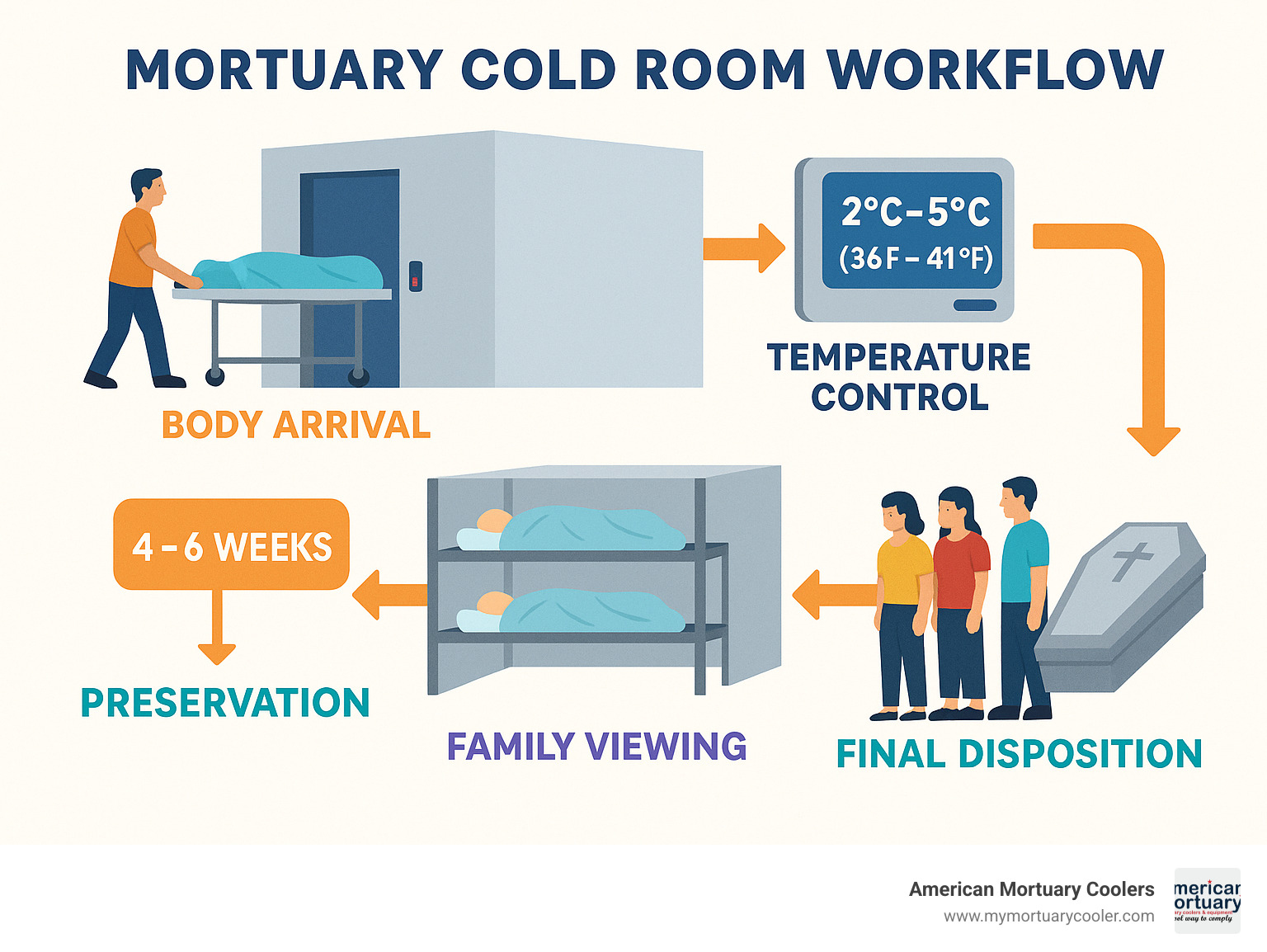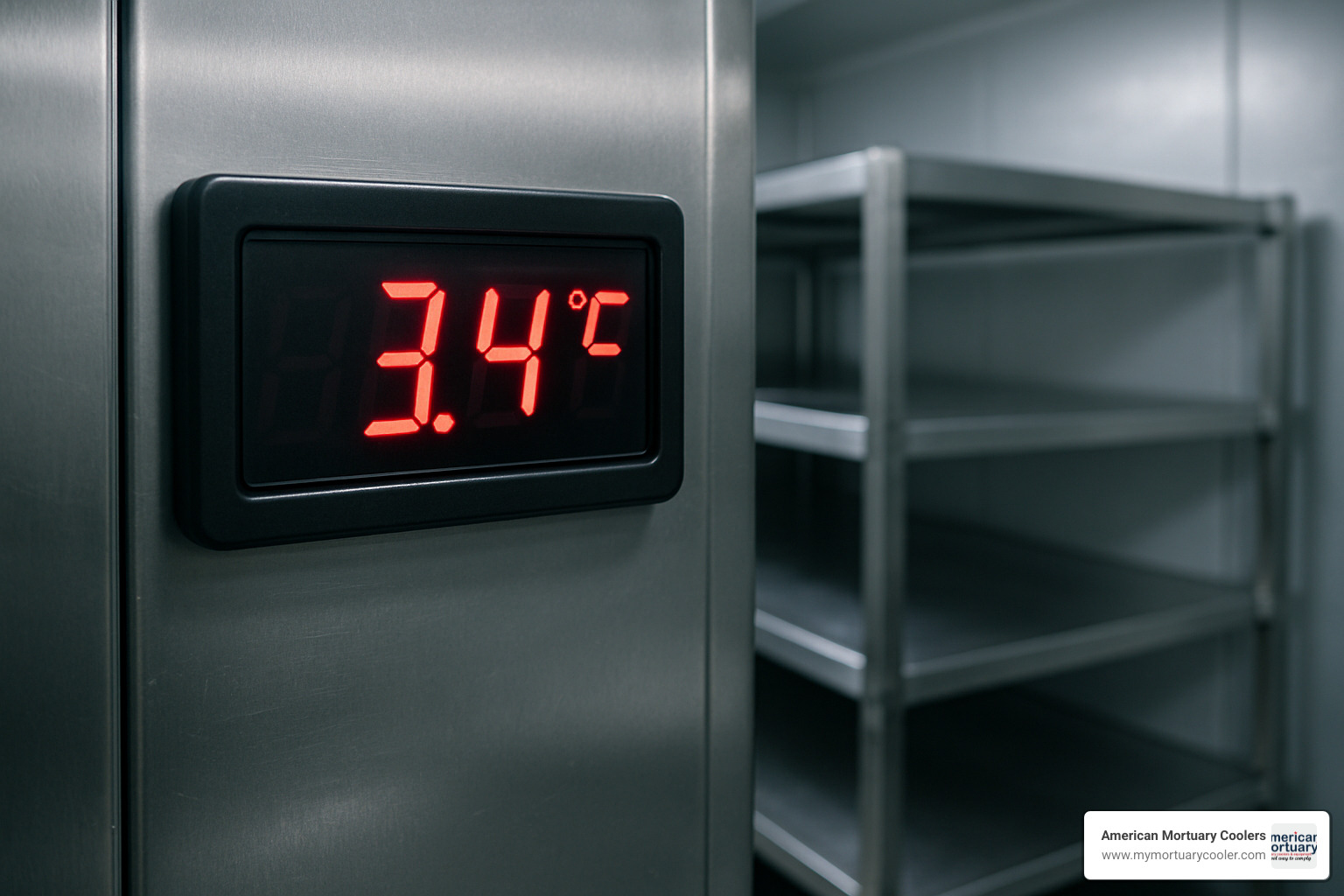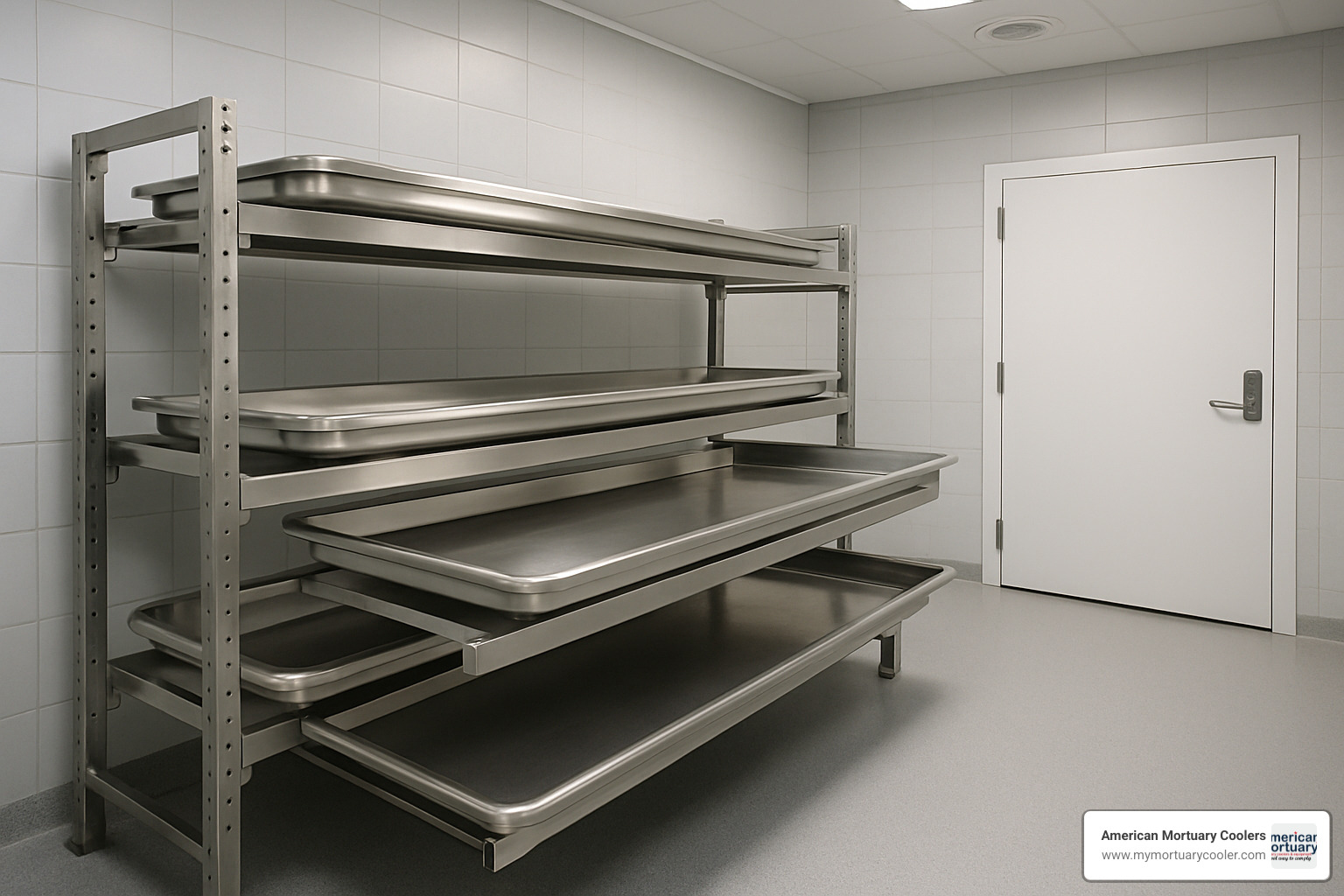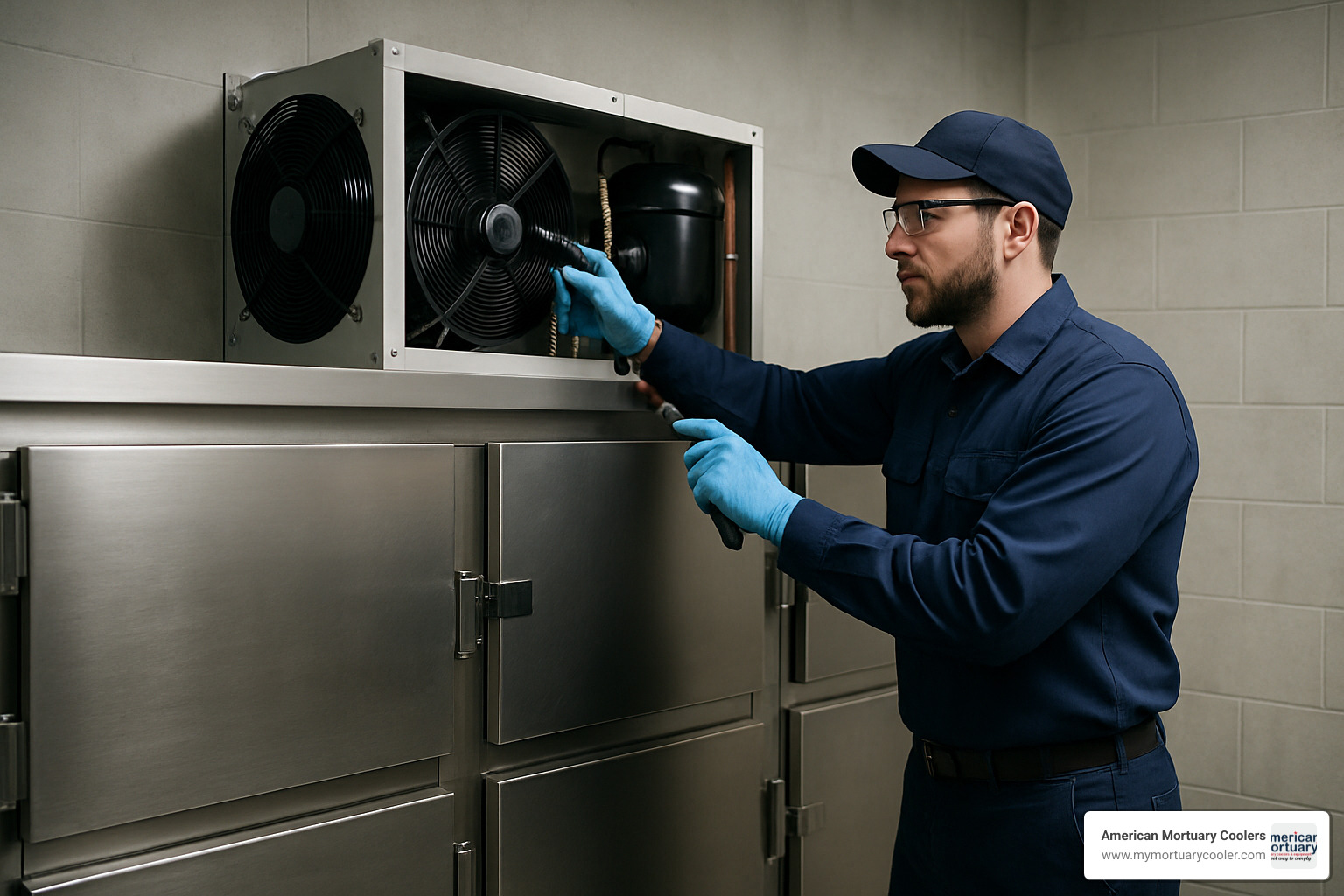
Mortuary Cold Rooms 101: Options, Features & Buying Tips
Why Mortuary Cold Rooms Are Essential for Modern Funeral Care
Mortuary cold rooms are specialized refrigeration facilities designed to preserve human remains at controlled temperatures, typically between 2°C and 5°C (36°F to 41°F). These essential systems serve funeral homes, hospitals, and forensic laboratories by slowing decomposition and maintaining dignity during the arrangement process.
Quick Overview: Mortuary Cold Rooms
- Primary Purpose: Preserve human remains by slowing decomposition
- Temperature Ranges: 2-5°C for standard preservation, -10°C to -50°C for long-term forensic storage
- Storage Duration: 4-6 weeks at refrigeration temperatures, months to years when frozen
- Capacity Options: Single body units to walk-in systems holding 50+ bodies
- Key Features: Stainless steel construction, digital temperature control, backup systems
As one funeral director noted: "The gift of time is priceless when families grieve." This captures what mortuary cold rooms provide - time for families to process loss while ensuring their loved ones are treated with respect and dignity.
Modern mortuary cold rooms feature advanced temperature monitoring, antimicrobial surfaces, and energy-efficient designs that can reduce operating costs by 15-25%. Whether dealing with space constraints or planning for mass-fatality preparedness, today's systems offer modular designs and mobile options that adapt to specific needs.
The science is straightforward: at proper refrigeration temperatures, bacterial reproduction slows by approximately 10 times, and enzymatic activity drops by 40-60%. This biological slowdown preserves tissue integrity for extended viewing periods, forensic examination, and accommodation of cultural or religious practices requiring specific timing.
I'm Mortuary Cooler, a national-level mortuary cooler supplier with extensive experience helping funeral homes and medical facilities select the right mortuary cold rooms for their specific needs.

Mortuary cold rooms terms simplified:
Mortuary Cold Rooms Explained: Purpose, Temperature & Preservation
Mortuary cold rooms are carefully engineered preservation systems that give families something precious: time. When someone passes away, these specialized chambers create the perfect environment to slow decomposition naturally, allowing families to gather, make arrangements, and say their goodbyes with dignity.
At room temperature, bacterial activity runs at full speed. But when we cool things down to that sweet spot between 2°C and 5°C (36°F to 41°F), everything slows to a crawl. It's like hitting the pause button on nature's processes, giving you weeks instead of days to handle arrangements.
For longer-term needs - particularly in forensic work - negative temperature chambers operating between -10°C to -50°C can preserve remains for months or even years. These freezing systems serve a different purpose than standard refrigeration, prioritizing long-term preservation over immediate viewability.

The difference between positive and negative chambers isn't just about temperature - it's about purpose. Positive chambers (above freezing) maintain natural appearance for 4-6 weeks of viewability, while negative chambers prioritize evidence integrity for forensic investigations.
More info about mortuary cold chambers
The Science Behind Decomposition Control
Decomposition occurs through two main culprits - bacteria and enzymes. Both are incredibly temperature-sensitive, which is exactly why proper cooling works so well.
When we drop the temperature to refrigeration levels, bacterial reproduction slows by about 10 times compared to room temperature. Meanwhile, the enzymes that break down cellular structures see their activity drop by 40-60%. This one-two punch of slowed bacteria and reduced enzymatic activity preserves tissue integrity for extended periods.
Humidity management plays a supporting role that's often overlooked. Most modern systems maintain relative humidity between 80-85% - enough to prevent tissue dehydration but not so much that it encourages bacterial growth.
Positive vs. Negative Temperature Chambers
The choice between positive and negative temperature chambers comes down to your specific needs and timeline. Positive chambers, running between 2°C and 5°C, are the backbone of most funeral homes and hospitals. They're perfect for the typical funeral timeline, maintaining natural appearance for viewing while giving families flexibility.
Negative chambers operating between -10°C and -50°C are primarily found in forensic facilities where long-term preservation trumps immediate appearance concerns. Bodies can be preserved for months or years, but freezing damages cellular structures, so tissues don't look as natural when thawed.
Some facilities invest in dual-zone systems that offer both temperature ranges in a single unit, providing ultimate flexibility for choosing the right preservation method based on each situation's unique requirements.
Storage System Options & Comparisons
Choosing the right mortuary cold rooms system depends on understanding your specific needs. Today's market offers everything from compact single-body units to massive walk-in systems that can handle 50 or more bodies during peak periods.
Walk-in coolers dominate the high-capacity market, typically storing 5-50 bodies depending on configuration. Body boxes and refrigerated cabinets serve smaller operations, usually holding 1-6 bodies each. Mobile pop-up units and container morgues provide emergency response and temporary capacity solutions.
Capacity planning should consider your typical weekly caseload, seasonal fluctuations, storage duration, and whether you need disaster response ready capabilities.
| System Type | Capacity | Installation | Best For | Typical Cost Range |
|---|---|---|---|---|
| Body Boxes | 1-6 bodies | Plug-and-play | Small facilities, backup storage | $6,000-$15,000 |
| Refrigerated Cabinets | 2-8 bodies | Minimal installation | Medium facilities | $15,000-$35,000 |
| Walk-in Coolers | 5-50+ bodies | Professional installation | Large facilities | $25,000-$100,000+ |
| Mobile Units | 4-24 bodies | Rapid deployment | Emergency response | $40,000-$80,000 |
More info about cooler options
Walk-In Mortuary Cold Rooms
Walk-in mortuary cold rooms are the workhorses of high-volume facilities. These systems use modular panels - typically thick polyurethane foam sandwiched between metal sheets - that can be configured to fit almost any space.

Side-loading racks allow bodies to be stored perpendicular to the wall rather than parallel, often doubling capacity without expanding the building. Large capacity walk-in systems typically handle 10 to 50+ bodies, with modular design allowing expansion as needs grow.
The build quality features industrial-grade components designed for continuous operation, with backup systems to prevent failures. Energy efficiency becomes a major advantage at this scale, with larger thermal mass providing more stable temperatures.
Body Boxes & Refrigerated Cabinets
Single-body units and small refrigerated cabinets are the unsung heroes of the mortuary world. These plug-and-play systems eliminate installation complexity while providing professional-grade preservation.
Body boxes fit through standard doorways, can be positioned almost anywhere with adequate ventilation, and accommodate 1-4 bodies with telescoping slide rails for easier loading. Refrigerated cabinets offer more capacity while maintaining simple installation, often featuring multiple compartments for separating different cases.
Mobile & Temporary Units
Pop-up tents and trailer containers can be deployed within hours while maintaining the same temperature standards as permanent installations. Polar Leasing rental options make these systems accessible for temporary capacity increases, equipment maintenance, or emergency situations.
Container morgues provide complete mortuary facilities including preparation areas and office space. Mass-fatality readiness has become crucial for emergency managers, with mobile units providing immediate cold storage capability during disaster response.
Powered by Polar Leasing, these rental solutions offer flexibility for handling unpredictable demand while maintaining the highest standards of care and dignity.
Key Features & Customization Options for Modern Mortuary Cold Rooms
When investing in mortuary cold rooms, you're buying a sophisticated preservation system designed with dignity, safety, and reliability at its core. These modern units incorporate features from smartphone monitoring to antimicrobial surfaces that actively fight contamination.
The foundation starts with high-density polyurethane insulation, typically 60-80mm thick, maintaining consistent temperatures while meeting fire safety standards. Stainless steel surfaces using AISI 304 grade material provide durability and cleanliness, with seamless construction eliminating bacterial hiding spots.
Door systems feature heated door jambs preventing condensation, magnetic gaskets sealing tightly, and crucial safety release handles complying with OSHA requirements. Digital monitoring has revolutionized cold storage management, with modern PID controllers maintaining temperatures within ±1°C and WiFi-enabled systems providing smartphone alerts.

Customization options include bariatric trays accommodating individuals up to 256 kg, adjustable racking systems configured for various equipment, and LED lighting reducing energy consumption by 75% while providing better illumination.
A-Z Guide to Mortuary Cold Room Door Manufacturers
Temperature Control & Monitoring
Modern mortuary cold rooms use sophisticated microprocessor-based PID controllers that continuously monitor and adjust cooling output. Data logging capabilities record temperature readings every few minutes, supporting regulatory inspections and troubleshooting.
WiFi connectivity allows remote temperature checking, instant alerts about temperature excursions, and setting adjustments from anywhere. Dual-zone systems combine positive and negative temperature sections in a single unit for maximum flexibility.
Backup systems ensure continuous operation during equipment failures, with redundant sensors preventing false alarms and battery backup maintaining monitoring during power outages.
Hygiene & Regulatory Compliance
Hygiene in mortuary cold rooms must meet strict health department standards. Seamless flooring eliminates contamination accumulation points, while coved bases curve smoothly from floor to wall.
Antimicrobial interior finishes actively inhibit bacterial growth, built into surface materials themselves. NSF certification ensures food-service grade standards appropriate for the highest hygiene levels.
Air circulation systems maintain proper airflow without temperature-affecting drafts. HEPA filtration removes airborne contaminants, with some units including UV sterilization for additional protection.
Capacity Planning & Shelving
Effective capacity planning requires thinking beyond typical daily needs. Facilities normally handling 2-3 cases might need capacity for 8-10 during flu season or unexpected events.
Side-loading shelving systems allow perpendicular storage, often increasing capacity by 50-100% in the same floor space. Roll-in cart compatibility eliminates manual lifting, reducing injury risk while speeding operations.
Bariatric accommodation requires special planning with reinforced shelving and wider door openings. Future expansion planning with modular systems allows capacity additions without replacing entire systems.
Energy Efficiency & Sustainability
Energy efficiency improvements translate directly to monthly utility bills. Modern systems with high-R-value insulation, efficient compressors, and smart controls reduce energy consumption by 15-25% compared to older units.
LED lighting reduces lighting energy consumption by 75% while providing better illumination. Eco-friendly refrigerants like R-134a provide excellent cooling with reduced environmental impact.
Smart defrost systems optimize cycles based on actual conditions rather than fixed schedules, while predictive maintenance systems monitor performance to identify potential issues before failures occur.
Buying, Operating & Future-Proofing Your Mortuary Cold Room
Purchasing a mortuary cold room represents a significant investment serving your facility for decades. Understanding total cost of ownership - not just purchase price - ensures the right decision for your needs and budget.
Capital expenditure includes equipment cost, installation, electrical work, and building modifications. Operating expenditure includes energy costs, maintenance, and replacement parts. Higher-quality systems may cost more initially but often provide better long-term value.
Monthly energy costs for walk-in coolers typically range from $150-$400, while smaller body boxes cost $50-$120 monthly. Preventive maintenance typically costs $800-$1,500 annually, while major repairs like compressor replacement range from $1,500-$3,000.
Cultural and religious considerations may influence system selection, with some practices requiring specific timing that makes reliable preservation critical.

More info about reliable manufacturers
Choosing the Right Supplier & Configuration
Selecting the right supplier involves evaluating not just equipment but complete support packages. Look for manufacturers with specific mortuary application experience, as requirements differ significantly from food service refrigeration.
Capacity analysis should consider current and future needs. Site constraints often drive configuration decisions - narrow doorways, low ceilings, or limited electrical capacity may eliminate certain options.
Electrical load analysis is crucial, especially for larger systems. Walk-in coolers may require 208-230V power, while smaller units operate on standard 110V circuits.
Installation, Training & Safety
Professional installation is critical for mortuary cold rooms. Improper installation leads to temperature problems, energy waste, and safety issues. Access routes must be planned carefully for modular panels and equipment delivery.
Body lifts and handling equipment improve safety and efficiency. Manual lifting creates injury risks, while hydraulic or battery-powered lifts often pay for themselves through reduced workers' compensation claims.
OSHA compliance includes safety release handles, non-slip flooring, adequate lighting, and proper ventilation. Staff training should cover normal operation, emergency procedures, and basic troubleshooting.
Running & Maintenance Costs
Energy costs typically represent the largest ongoing expense. Energy audits can identify optimization opportunities through temperature setpoint adjustments, improved door seals, or LED lighting upgrades.
Coil cleaning is crucial maintenance - dirty condenser coils increase energy consumption by 20-30% while reducing capacity. Quarterly cleaning is typically recommended, though dusty environments may need more frequent service.
Compressor warranties vary significantly between manufacturers. Standard coverage is typically one year, though extended warranties of 4-5 years are available. Given replacement costs of $1,500-$3,000, extended warranties often provide good value.
Future Trends & Upgrades
The future includes smart sensors and IoT connectivity providing detailed monitoring and predictive maintenance. AI-driven systems will optimize energy consumption and predict maintenance needs before failures.
Dual-zone combination systems offering both refrigeration and freezing capabilities in single units are becoming more popular. Modular add-on capabilities allow systems to grow with facility needs rather than requiring complete replacement.
Eco-friendly refrigerants continue evolving, with natural refrigerants like CO2 offering excellent performance with minimal environmental impact.
Frequently Asked Questions about Mortuary Cold Rooms
How long can a body be stored safely?
Bodies stored in mortuary cold rooms at standard refrigeration temperatures (2-5°C) can typically be preserved in viewable condition for 4-6 weeks. Freezing temperatures (-10°C to -50°C) can extend preservation for months or years, primarily used in forensic applications.
What are typical running costs & how to reduce them?
Monthly energy costs range from $50-$120 for body boxes to $150-$400 for walk-in coolers. Reduction strategies include upgrading insulation (15-25% savings), LED lighting (75% less energy), regular condenser coil cleaning, and optimized defrost cycles.
Can mobile units meet regulatory standards?
Yes, quality mobile mortuary cold rooms meet the same regulatory standards as permanent installations. Modern mobile units use NSF-certified materials, include OSHA-compliant safety features, and provide the same temperature control and monitoring capabilities as fixed systems.
Conclusion
Mortuary cold rooms represent far more than refrigeration equipment - they're essential tools enabling funeral service professionals to provide dignified care during families' most difficult times. The gift of time these systems provide allows for proper funeral planning, family gathering, and the closure that comes from being able to say goodbye properly.
Key takeaways:
- Temperature control between 2-5°C provides 4-6 weeks of preservation for most applications
- System sizing should consider both typical and peak demand scenarios
- Energy-efficient features can reduce operating costs by 15-25%
- Mobile and modular options provide flexibility for changing needs
- Professional installation and regular maintenance ensure reliable operation
- Future-proofing through modular design protects your investment
At American Mortuary Coolers, we understand that every facility has unique needs. Whether you're a small family funeral home requiring a compact body box or a large hospital morgue needing a walk-in system with 50+ body capacity, we provide custom solutions with direct delivery across the contiguous 48 states. Our Tennessee-based operation combines decades of industry experience with the flexibility to customize systems for your specific requirements.
The mortuary cold room industry continues to evolve with smart monitoring, eco-friendly refrigerants, and energy-efficient designs. By choosing quality equipment from experienced suppliers and maintaining it properly, your investment will serve families in your community for decades to come.
As that funeral director told us: "The gift of time is priceless when families grieve." Your mortuary cold room provides that precious gift while ensuring the dignity and respect every family deserves.



